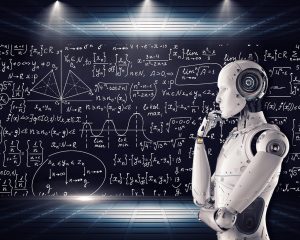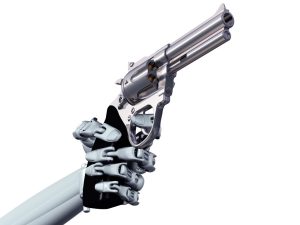2
Josh Finglass
Introduction
Keywords
Artificial Intelligence
Machine Learning
Turing Test
Autonomy
Concerns
Safety
Learning Objectives
- Define Artificial Intelligence and its history
- Define machine learning and its uses
- Determine current uses of AI and their dangers
- Determine future uses of AI and their dangers
Background/History
Artificial intelligence, also known as AI, is a recent and rapidly evolving technology in society today. With its rapid evolution, concerns have been raised in many areas behind the use of this technology.
The term artificial intelligence was first defined in the 1950’s by John McCarthy. McCarthy defined AI as machines that could think autonomously. Today AI can be defined as machines that respond to stimulation consistent with traditional responses from humans, given the human capacity for contemplation, judgment, and intention.” Comparing the conceptual definition coined in the 1950’s to the modern-day definition based on application, we can see how much AI has truly changed in its short ~70-year lifetime.
Following the original definition of machines thinking autonomously, the Turing Test was created to see if machines were truly considered AI. The Turing Test specifies that computers need to complete reasoning puzzles as well as humans in order to be considered thinking in an autonomous manner. To date very few machines have ever been considered to have completed the Turing Test. The first instance where a machine was believed to have completed the Turing Test was in 2014. The computer simulated a 13-year-old boy and it was believed that the computer could think on its own. It is accepted that this is one of only a handful of machines to ever complete the test.

Machine Learning
Machine learning plays a large role in the development of AI. Machine Learning can be defined as when given a goal, learning machines adjust their behavior to optimize their performance to achieve their goal. Machine learning has played a large role in the advancement of technology today. Applications of machine learning can be seen all over the world. One of the most basic and newsworthy examples is an autonomous dart board created by Mark Rober, a former NASA engineer and current youtuber. Rober created a system in which a traditional dart board would move to intercept a dart and guarantee a bullseye almost every time. Machine learning was instrumental in this application because from the time the dart is released to when it hits the board, there is less than a second for the machine to respond and move. Rober used machine learning by throwing the dart thousands of times, allowing the machine to analyze everything from the release angle, release velocity and landing location. The machine is then able to learn from and use this data to guarantee a bullseye almost every time. While this is a basic example of machine learning, the opportunities for application of machine learning are endless.
Misconceptions
Due to its quick evolution and general lack of understanding from the public, AI is commonly misconceived in the public eye. AI is commonly thought of as robots that will take over the world, however, it is not true for the applications today. AI can be seen everywhere from your house, car, office and so much more. Many of these applications people use every day without realizing that AI plays a key role in their technology.
Current Uses
AI is rapidly evolving which is driving an expansive use of the technology in our lives. Current uses of AI can be seen in a diversity of fields today.

Autonomy
AI is seen today in your household, your office and your car. One basic use of AI in homes is through the “Roomba” robots. These robots traverse your household autonomously cleaning up messes. Through the use of AI, these robots know where to travel and how to find a mess to clean. Another use of AI can be seen in our smartphones. Algorithms that use machine learning study users’ habits in an effort to display information and make suggestions for the user that are considered most useful. For example, current smartphones will suggest alarm times for the next day when you are going to bed by using machine learning that has studied your habits from previous days. AI has also played a key role in the development of technology and autonomy. This can be seen in things such as your car. The development and use of self-driving cars use AI in many ways. These cars leverage AI to keep you safe by studying the changing environment around you as you drive. Using this information, the cars are able to determine if the path ahead of you is still safe. AI also plays a large role in keeping the fast-paced world we live in today moving smoothly. Banks all over the country implement AI in a meaningful way. Banks use AI to track our spending patterns in efforts to identify fraudulent charges so they can keep their clients’ money safe. AI has also been implemented into factories and distribution centers all over the country. AI is used in factories to help assemble items as well as improve product control. Machines are able to watch the assembly process and determine if there may be possible defects in the parts being put together. AI is used in distribution centers, such as Amazon and many other companies, to help determine how to sort items to increase efficiency. AI plays an important role in keeping us safe every day. Applications of AI are used to help defend us on the internet from attacks by identifying malicious attacks on software. Overall AI plays a large role in our everyday lives.
Dangers and Concerns
AI is pictured by some people as a threat to the world today for a variety of reasons. Some people believe that there are dangerous applications of AI as well as economic impacts from its use.
Dangers and Concerns of Current Uses
AI is often made out to be a scary technology because of preconceived notions. Although some of these fears may be unreasonable, some of them are valid and can be seen today. One large fear of AI is safety in autonomous cars. This is currently a rapidly evolving technology, but it does pose many dangers. While these cars are wonderful forms of transportation, they are not perfect. Without proper oversight, many deaths can occur and have occurred already from autonomous cars. Another large concern is the impact AI can have on the economy when placed into factories. Many machines in factories use a form of AI and these machines are slowly replacing the jobs of humans in factories. These machines are slowly starting to take more and more blue-collar jobs, leading to an overall loss of jobs, which can hurt the economy as a whole as well as the economy of towns based around these factories and lead to larger gaps in socio-economic statuses. Another concern in the use of AI is the safety behind our information. While we use AI to protect our information, it does have flaws. AI is used in our phones to track patterns from data and there are concerns that this data could be misused or stolen in ways that would hurt users. These are just some of many concerns raised when using AI in the world today.

Dangers and Concerns of Futures Uses
While we may not know what the future has in store for us, the ideas and developments of AI can be a cause for large concern. Many concerns stem from the development and future uses of AI in the military. None of these developments are a reality yet, but they still pose an area for concern. One of these areas of apprehension is the development of autonomous weapons and warfare. This causes unease because it can lead to a massive loss of life. Another concern behind autonomous weapons and warfare is the judgement of AI when determining if a target could be friendly or not. AI is also being used in the military in the development of technologies such as drone swarming. These are autonomous drones that can drop bombs, take out planes and so much more. This is just one of many applications that the military is developing that is an area of major concern. The future development of “killer” robots through the use of AI creates apprehension for many people. We have all watched movies where robots learn to feel and take over the world. While this is something that is a long way away from being a reality, there are genuine concerns about safety. The use of more sophisticated AI in the future is a large concern because it will lead machines to being smarter. Overall, there are many concerns focusing around the future development of AI.
Chapter Summary
- AI has a short history that has seen rapid evolution. This evolution can be seen through the development of its definition as well as its uses.
- Machine learning plays a large role in the use of AI and its evolution.
- For many reasons AI has been misconceived in our society today. However, many of these misconceptions are currently unobtainable.
- AI is used everywhere in our world today, whether we realize it or not. Many of these uses are applied constantly in our everyday lives.
- AI has many applications today however there are concerns behind the safety of these applications.
- AI is currently being used to develop many different things. Some of these applications are not necessarily all “good” and raise concerns about the safety behind these uses.
Review Questions
When was the term AI first coined?
-
- 1940’s
- 1950’s
- 1960’s
- 1970’s
2. Who first coined AI?
- John McCarthy
- Mark Rober
- Albert Einstein
- Steve Jobs
3. How many machines are truly considered AI?
- 0
- 50
- <5
- >100
4. What is Machine Learning?
5. What are some dangers of AI?
Answers
1-b, 2-a, 3-c
References
Kavanagh, C. (2019). New Tech, New Threats, and New Governance Challenges: An Opportunity to Craft Smarter Responses? (pp. 1-5, Rep.). Carnegie Endowment for International Peace. doi:10.2307/resrep20978.3
Scharre, P., Horowitz, M., & Work, R. (2018). ARTIFICIAL INTELLIGENCE: What Every Policymaker Needs to Know(pp. 4-9, Rep.). Center for a New American Security. doi:10.2307/resrep20447.5
Johnson, J. (2020). Artificial Intelligence: A Threat to Strategic Stability. Strategic Studies Quarterly, 14(1), 16-39. doi:10.2307/26891882
West, D. M. (2019, October 25). What is artificial intelligence? Brookings. https://www.brookings.edu/research/what-is-artificial-intelligence/.
Columbus, L. (2020, May 19). 10 Ways AI Is Improving Manufacturing In 2020. Forbes. https://www.forbes.com/sites/louiscolumbus/2020/05/18/10-ways-ai-is-improving-manufacturing-in-2020/?sh=7377d0251e85.
EC-Council. (2019, December 17). The Role of AI in Cybersecurity: EC-Council Official Blog. EC. https://blog.eccouncil.org/the-role-of-ai-in-cybersecurity/.
